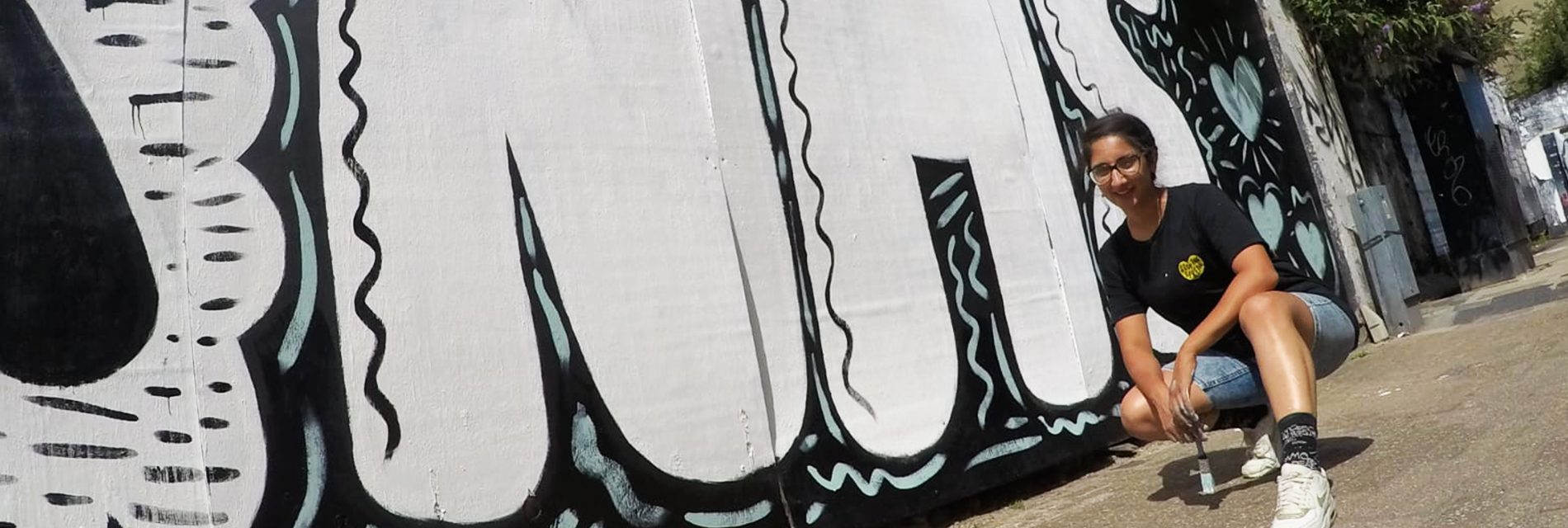(July 4, 2024) When she thinks of her art, Harkiran ‘Harky’ Kalsi remembers a quote by singer Nina Simone, “An artist’s duty is to reflect the times.” Harky lives by her ideal – the 37-year-old Indian-origin artist-activist has worked with some of UK’s largest charity initiatives, including Comic Relief, Children in Need and Sports Relief and designed sculptures for a social campaign thanking the NHS for their work during the pandemic. A client list that includes NBA, Lululemon, Footlocker, Vintage Books and the London Marathon, with each project, she raises her voice for a social cause. The fact that “south Asian artists are so rare,” only makes her efforts more pertinent. “This is my effort for the Indian community,” Harky says in an interview with Global Indian. “Who knows how many Indian girls will see my work and think, ‘hey, I want to do that too?’”
Growing up in UK’s Midlands, she is no stranger to racism- of clerks treating her mother poorly over an Indian lilt, only to change when Harkiran walked in with a Brit accent. She even dismissed her roots of being a Punjabi Sikh, of feeling ashamed when her mother cooked a tadka, afraid the smell would stick to her clothes. And merely standing helpless as a person was discriminated against for the colour of their skin.

Harkiran Kalsi
It was Charlie Dark, founder of the Run Dem Crew, who gave her a valuable piece of advice. “You’re an artist,” he told her, “Put together a work of art that expresses your message.” So she did. Before she knew it, the work was getting scores of downloads across the UK. “This is what my work needs to do,” she declared.
The early days
Harky’s earliest memories are of drawing at seven or eight, or even earlier. Her mother moved to England from Punjab when she married, and was creatively inclined too, “I remember art as being my entire life, I have never done anything but create it.”
She dreamed of being an illustrator. Yet life ensured her path to being an artist was riddled with obstacles. She failed art and design in her ‘A’ levels, coming away devastated when a teacher said, “You will never amount to anything as an artist.” Her mother, who had been a teacher in India, simply said, “Don’t panic. It doesn’t mean you’re stupid, it just means you have a different way of thinking.”

At Coventry University, an art foundation course opened the doors to a wealth of new options. Finding herself inclined towards illustrations, next came a graphic illustration course. “I put down the wrong course, though,” Harky exclaims. “I ended up in graphic design instead.”
After college, acting on the advice of an uncle, Harky Kalsi found work resizing artwork for pubs and hotels. The next four years were spent on graphic design work, hoping to find her space in London someday.
“It was a struggle,” Harky remarks, adding, “Just a series of rejections.” Household expenses, supporting her mother and sister were her priority. Rejected constantly, not told why – she was headed for a breakdown.
The Secret

The I Am Thankful For series
Then in 2013. Harky Kalsi remembers, “crying her eyes out.” Her lowest point yet, Harky remarks, “I couldn’t just give up and quit, could I? I had to change something about myself.”
That’s when her sister gave her The Secret by Rhonda Byrne. “I realised I was living in a state of mind where I felt like everything was against me,” and she soon discovered ideas like manifestation and gratitude. “Another book The Magic recommended thinking of one thing you’re grateful for, every night before you sleep,” she says.
It helped her understand what she needed to do. Weeks later, she got an interview for BBC Worldwide. First round checked, turned down in the second, she suddenly felt it was okay. A few hours later, she spotted another opening at the BBC – this time with Children in Need. “I took my mother with me for the interview,” she smiles. She finally landed that job in 2014, at 29, and London came calling. She was jubilant.
London calling

When Children in Need moved to Manchester, she found work with Comic Relief with passion projects on the side. One such personal project was, “I’m Thankful For.” As the days rolled by, Harky saw a typographical style beginning to appear. “I was always interested in typography but never thought it would become my actual style,” she explains. Soon, people started contacting her to create prints. Harky was on her way.
Finding freedom
When Comic Relief announced that the team was being made redundant, again at familiar crossroads, Harky Kalsi toyed with starting out on her own. In 2017, she finally did, giving herself two weeks to find work.
“I was doing graphic design and my personal illustrations. It has been incredible ever since,” she says. “I genuinely believe that if I hadn’t made that change in my mindset in 2013-14, and learning to take rejection in my stride, none of this would have happened. The rejections simply guided me towards the path on which I truly needed to be.”
“I’m at a 50-50 balance now,” says Harky exploring what it means to be South Asian, Indian and a woman living in the UK. She had earlier moulded herself to fit, “into this white, British way of being. It took me years to learn to love who I am,” she readily admits.

The artist’s duty
All her projects have a strong social message – a voice against social, racial and political injustices. With her bright colours and bubble letters, she’s currently standing up against the conflict in Ukraine.
A passionate marathoner, Harky’s clients include the London Marathon, sports apparel brand Lululemon, Footlocker and the NBA. In 2021, Harky became part of The Stolen Starts, a global running community that comprised 10 women from major cities (New York City, LA, London, Paris and Tokyo, etc). She designed race kits for Stolen Starts’ members who competed in the 2021 New York City Marathon.
Harky Kalsi has lent her voice – and art – to the Stop Asian Hate movement and for women’s rights. Her Instagram following has grown. After the pandemic, she took a project to create three sculptures that would be taken around the UK, a tribute to the NHS, whose workers had been on the frontlines of the pandemic.
One day, she was approached by Vintage Books and asked to illustrate a response to a quote by Kamala Harris, from her New York Times bestseller, The Truths We Hold. “This was part of a campaign to coincide with the inauguration in January 2021,” smiles the artist of the video that received 20,000 views on Vintage’s platform.

Her voice only grows louder – and bolder. “Lettering isn’t just lettering, you know?” she avers. “Words are so powerful. And art must make an impact or make people think. I don’t care if people agree with my work or like it, but if I can get them to have a dialogue, to think, then my job is done.”
- Follow Harkiran on Instagram
Also Read: Tadam Gyadu: Meet the comic book artist crafting superhero dreams for Marvel
Also Read: Tee time: Bharath Arvind is making golf accessible through The Golfer’s Edge Chennai



